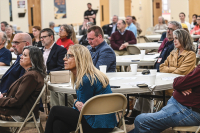Tight times force tough choices for Swain schools
The Swain County School District has terminated a popular program that emphasized science and math education, offered students smaller classes and helped combat the system’s high dropout rate.
The three-year-old School of Applied Science, Math and Technology was axed last month, despite having two more years of grant funding left. It had 160 students out of 600 at the high school.
The SASMT got a five-year grant from the N.C. New Schools Foundation, which funds programs that offer an alternative approach to traditional high school curriculum.
While the program didn’t cost Swain schools anything thanks to the grant funding, that grant would run out in two more years and the school system would have to shoulder the cost of about $52,000 annually. Administrators felt it would be impossible for them to come up with the money, and opted to throw in the towel sooner rather than later.
“We studied our options for over six months before we made that decision,” said Regina Ash, head of instruction for the Swain County Schools system. “We studied options, we argued about it. This was not something we took lightly. It was not a first choice, but with the budget going the way it is going we felt this was the best option for us.”
The alternative style of learning offered by the SASMT proved popular. Few students left the program, and it boasted an extremely low dropout rate — only one pupil in three years. A review commissioned by the New Schools Foundation gave the SASMT high marks in October 2008, finding that, “achievement has been consistently above district averages in all core subjects.”
Related Items
“You in essence are closing down a program that has proven to be very effective,” said Sam Houston, president and CEO of the North Carolina Science, Math and Technology Education Center.
While Houston said he cannot speak to the school’s situation, he questioned any decision to terminate the program before the grant ran out.
“It would be wise for them to continue for the next two years,” he said.
The SASMT principal, Jeff Payne, expressed disappointment in the program’s termination.
“We hate to see it going away,” Payne said. “We feel like we were successful, but it’s just one of those things that we hope to learn from the experience.”
The high school has pledged to incoporate the education principles from the special science and math program into all classrooms school wide.
The wrong equation?
The success of the SASMT lay partly in its small size, which helped cultivate an intimate learning environment.
The program operated like a school within a school, with students in the same building but segregated from the regular student body for most of their classes, enjoying smaller class size and a more intimate setting.
“It’s building the relationship on a deeper level, so that the teachers know the kids, their problems, and their families,” said Ash. “When kids and teachers know each other better, they both perform better. The depth of understanding helps the relationship on both ends.”
But with all their perks, small classes in an underfunded, rural school district like Swain’s present a host of challenges. Already in Swain, there aren’t enough teachers to go around. The SASMT was sharing teachers with Swain County High School, and with its multiple small classes was stretching teaching resources even further.
“As a small school, the quota of teachers is small and insufficient to cover even the core subjects for all students,” noted the New Schools review.
Limited teaching resources proved to be a fatal blow to the SASMT.
“We started splitting those groups up, and we didn’t have the teacher resources to do it the way they’re supposed to be done,” Payne said.
The school district would have had to hire additional positions as required by the SASMT, including a principal and guidance counselor — a move the system likely couldn’t afford when the time came.
“The problem is they require you to have a separate principal and a separate guidance counselor,” said Steve Claxton, community schools coordinator for the district. “We’re talking about very few students to do those things, and we didn’t see it being fiscally possible for us to continue to have two principals, and a guidance counselor just for (SASMT).”
Particularly, Claxton said, when the district is already facing the possibility of eliminating existing positions in its budget cutbacks.
“We’re looking at losing teachers. How are we going to come up with money to pay people that we don’t pay now?” he said.
But Houston says the benefits students reap from the program make the upfront cost worthwhile.
“You have a very small student population, so when you calculate the per pupil cost, it looks like they are terribly expensive,” Houston said. “But the truth is, the return on the investment is huge.”
While a lack of funding for new positions played a role in the termination of the SASMT, Payne believes small classes could be an inherently flawed approach at small, rural schools. That approach may have worked well in larger districts the New Schools Foundation first experimented with, but likely won’t play out the same way in smaller ones.
“They’ve tried to go to smaller schools, and that’s part of the problem — we’re already a small school to start with,” said Payne.
Even when the SASMT merge back into the rest of the student body, the student population of Swain High School will total about 600.
“I’d rather have a high school with 200, but when you start getting into those really large schools, then you’re looking at losing the relationship component,” Payne said. “Those are the schools that the new schools project will work better for.”
Ironically Payne believes that the small classes that made the SASMT work led to its downfall.
“It got worse and worse to be able to have those small classes, and in my opinion, the division of resources to different programs limited what people could actually do,” he said.
So while the New Schools Project may contain some beneficial ideas, some of them are impossible to apply at smaller schools, says Payne.
“It’s not the New Schools project’s fault that we don’t have the resources, but there’s only so much you can do with what you have.”
Math, science won’t disappear
Swain cut the SASMT at a time when an increasing importance is being placed on math, science and technological education. But the subjects weren’t a factor in the decision to end the program, said Claxton.
Instead, the additional cost the district would have to incur to continue the SASMT when its grant ran out was a deterrent.
“They’re expecting us to continue to run it, versus all the other programs already in place — things like athletics,” Claxton said.
But Payne says it’s more important than ever that students learn the subjects taught by the SASMT.
“Pick up any magazine, or go on-line, and look at what jobs are going to be needed in the next 20 years,” he said. “The world’s changing, and technology is a big part of it, and science and math are a part of that technology.”
Payne worries that those subjects won’t play as big of a role in the regular curriculum.
“It’s not going to be as big of a focus probably,” he said. “I think we had more emphasis, not just by giving them a couple more classes, but also by integrating those areas into their classes.”
Ash, though, assures that the school is making steps to incorporate those subjects into everyday classes, and make sure students know how to apply them in the outside world.
“Our teachers are embedding technology in their instruction, and when our kids are doing projects, they are using technology in presentations,” she said. “We’re making sure that the work they produce is more relevant and more connected with what they’ll be producing in the workplace.”
Plus, the district is emphasizing math and science education in the curriculum.
“We’ve been building our science and math program for a while, and trying to offer advanced courses for our students,” Ash said, like a yearlong Advanced Placement course that covers Physics and Pre-Calculus.
“We’ve learned a lot”
All in all, Swain County school officials say the SASMT was anything but a wash. In fact, the professional development it provided taught the district some valuable lessons and approaches it hopes to hold on to.
“We’ve learned a lot from it, and we’ll incorporate some of those things into the system next year,” Claxton said.
Payne tends to agree.
“A lot of the stuff we learned from this experience we’re going to keep,” he says. “Hopefully, students aren’t going to be missing much at all.”
Payne would like to see lasting change result from the SASMT concepts.
“I’m hopeful that we’ve learned a lot, and that we’re changing the culture of the whole high school and the way that teachers and students interact with one another,” he said.









